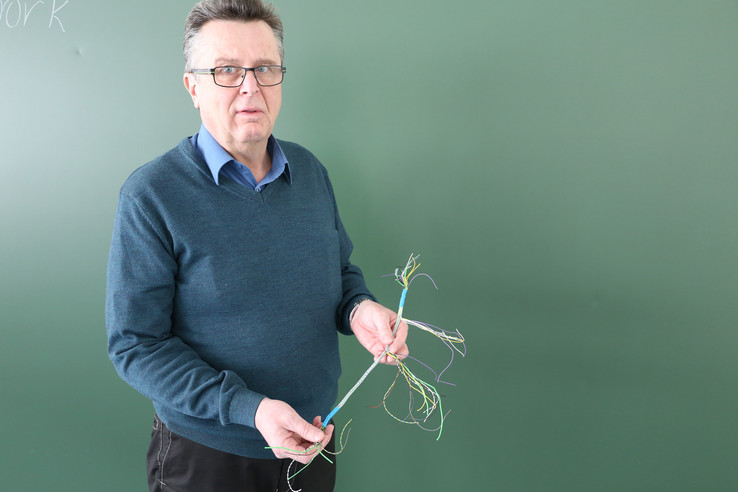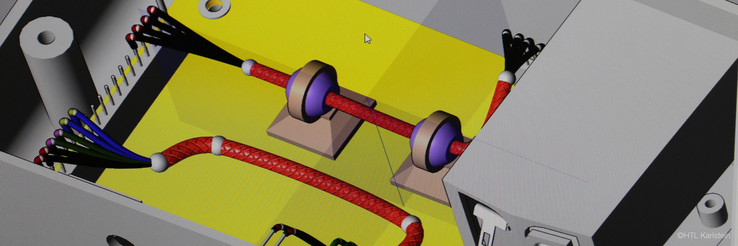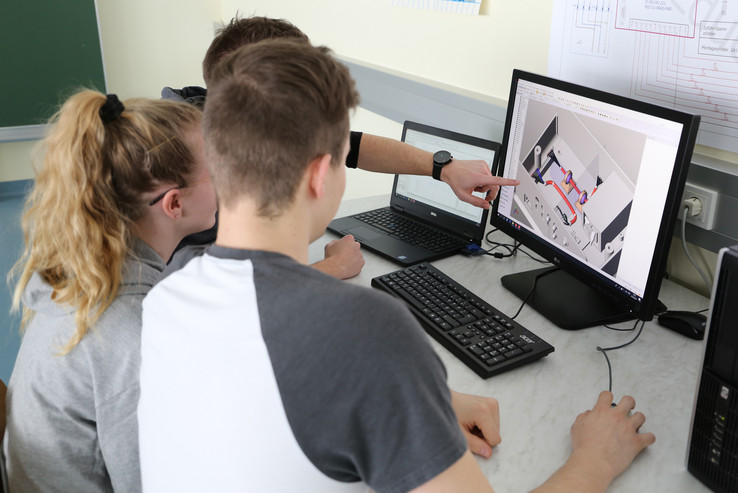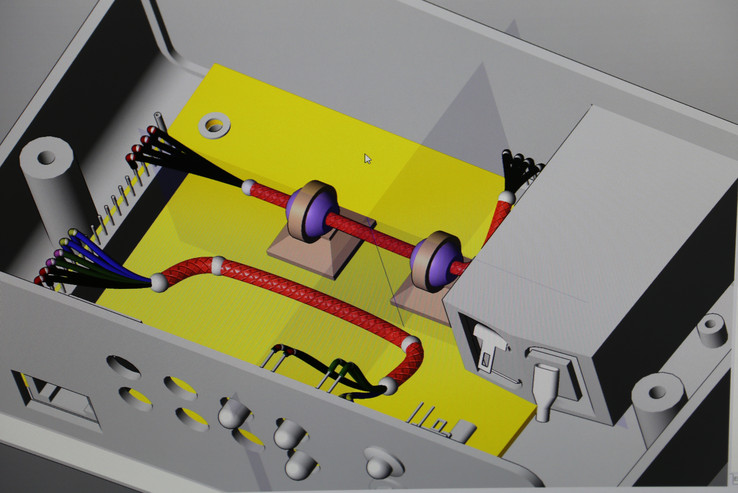진행 상황에 대한 3차원적 시각
30년 이상의 경력을 보유한 Franz Widhalm은 강의가 명확하고 미래 지향적일수록 학생들의 집중력이 더 오래 지속된다는 것을 알고 있습니다. 오스트리아 발드피어르텔 지역에 위치한 오스트리아 기술 대학교(HTL)에서 메카트로닉스 설계를 가르치는 전문 도구 설계자 Franz Widhalm은 작업 세계에서 지속되는 니즈에 최대한 실용적인 방식으로 대처하고자 노력합니다. 그 일환으로 Widhalm은 다음 학년도에 디지털 트윈의 가상 커미셔닝을 강의할 예정이며, EPLAN Harness proD가 설계와 관련해 핵심 역할을 하게 될 것입니다.
물리적 프로토타입은 이미 과거의 것이 되었습니다. 오늘 날에는 니즈를 충족하기 위해 디지털 트윈을 점점 더 많이 테스트하고, 개선하고, 적응시키고 있습니다. 그리고 Franz Widhalm은 이러한 동향을 실제 교육에 포함시키고자 합니다. 따라서 다음 학년도 HTL 칼스테인 기술 대학교 커리큘럼에 기계와 시스템 및 디바이스의 가상 커미셔닝을 포함하기로 결정하게 됩니다. 그리고 해당 수업에서 EPLAN Harness proD가 창조적인 역할을 하게 될 것입니다. “이 소프트웨어에 대한 학생들의 수요는 이미 간접적으로 표출되고 있습니다. 이해하기 어려운 회로도를 3차원으로 표현할 수 있는지 물어보는 학생들이 매우 많았기 때문입니다.” Widhalm은 말했습니다. 이러한 이유로 Widhalm은 와이어 하네스 설계를 위한 EPLAN의 전문 도구를 더욱 주의 깊게 살펴보게 되었습니다. 암스테텐에서 며칠간의 기본 교육을 받은 뒤에는 3D 소프트웨어에 대한 확신을 갖게 되었습니다. “우리 학교가 필요로 하던 것을 소프트웨어 설계가 전부 채워줄 수 있다는 것을 깨달았습니다. 설명이 크게 필요하지도 않습니다. 다른 소프트웨어 시스템에서 데이터를 불러오는 것이 매우 쉽기 때문에 아주 짧은 시간 내에 사용법을 터득할 수 있습니다. 생산을 위해 실물 크기의 탬플릿을 생성하기 위해서는 마우스만 몇 번 클릭하면 됩니다.” 이렇게나 칭찬을 하는 이유는 자동 어셈블리 기계를 위한 2D 네일보드 도면을 자동 생성할 수 있기 때문입니다. 이는 사전 정의된 경로를 따른 와이어 및 케이블 라우팅, 접점 포지셔닝 및 자재명세서 생성만큼이나 쉽습니다. 최소 곡률 반경과 단면, 번들 직경 등에 대한 타당성 검증도 소프트웨어 기능 중 하나로 제공됩니다.
설계 투명성 향상
와이어 하네스 엔지니어링에서 가장 어려운 점은 기계 및 전기 엔지니어링을 상호 연결하는 것입니다. 그리고 EPLAN Harness proD가 이 두 부문을 지능적으로 연결할 수 있습니다. 적절한 인터페이스와 중립 데이터 포맷 지원 덕에 MCAD와 ECAD 시스템 간의 매끄러운 통신이 가능하기 때문입니다. “본인만의 플러그 정의도 빠르게 할 수 있습니다. 평소 쓰는 3D 소프트웨어에서 그린 뒤, Harness proD 라이브러리로 불러오면 바로 사용할 수 있습니다.” Franz Widhalm은 말합니다. EPLAN 하네스 소프트웨어를 사용한 첫 번째 모델링 시도에서 특히 마음에 쏙 들었던 또 다른 기능은 ‘접점 간 거리를 통해 시스템이 필요한 케이블 길이를 자동으로 계산’한다는 것이었습니다.
2018/2019 학년도가 되어서야 학생들이 공식적으로 EPLAN Harness proD를 사용할 수 있게 되겠지만, 일부 학생들은 이미 ‘포인트 앤 클릭(point-and-click)’ 방식을 사용하는 직관적인 와이어 하네스 설계를 맛보기도 했습니다. “고급 과정에 있는 몇몇 학생에게 미래가 어떻게 펼쳐질지 살짝 보여주었습니다. 학생들의 피드백은 모두 긍정적이었습니다. 수업에서 바로 사용하고 싶다는 피드백도 있었고, 제어 판넬 내에서 개별 케이블과 와이어들이 어떻게 포지셔닝되는지 현실적인 3차원 표현으로 볼 수 있다면 설계를 배우는 데 엄청난 도움이 될 것 같다는 피드백도 있었습니다.” HTL 칼스테인 기술 대학교의 부교수 Widhalm은 EPLAN 와이어 하네스 솔루션에 대한 학생들의 엄청난 관심에 주목했습니다. 가을 학기부터 EPLAN 도구가 본격 사용됩니다. “우리 대학은 1990년대부터 EPLAN 소프트웨어를 강의에 사용한 학교 중 하나입니다. 보통은 작은 유체 동력 프로젝트를 시작해서 간단한 회로도를 생성합니다만, EPLAN Harness proD를 사용하면 매우 구체적인 방식으로 가상 커미셔닝을 가르칠 수 있게 됩니다.” 설계의 3차원적 표현은 현실적인 테스트도 가능하게 합니다. “해당 소프트웨어를 통해 개인의 상상력을 최대로 발휘할 수 있습니다. 개별 케이블이 어느 정도 구부러졌는지, 케이블 길이 설계에는 문제가 없는지, 최적화를 수행해야 하는지 확인할 수 있습니다.” Franz Widhalm은 EPLAN Harness proD를 사용하면 향후 개발 프로젝트의 품질이 개선될 것이라고 설명했습니다.
저자: 오스트리아 프리랜서 저널리스트 Sandra Winter
With more than 30 years of experience, Franz Widhalm knows that the clearer and more future-oriented the lessons, the longer the attention span of students. The skilled toolmaker, who teaches mechatronics design at an Austrian technical college (HTL) in Waldviertel, endeavours to familiarise himself as practically as possible with the ongoing needs of the working world. His latest coup, planned for the next school year, is the virtual commissioning of digital twins. And he is casting EPLAN Harness proD in a leading design role.
Physical prototypes are a thing of yesterday. Digital twins are now increasingly being tested, refined and adapted to meet the needs of today. This is a trend that Franz Widhalm wants to include in practical training. The virtual commissioning of machines, systems and devices is therefore to be part of the curriculum at the HTL Karlstein technical college from next school year. And EPLAN Harness proD will also be playing a leading creative role. "Indirectly, students have already been demanding this software. On numerous occasions I've been asked whether it's possible to three-dimensionally display things in a circuit diagram that are difficult to discern", recalls the senior lecturer. This was the impetus for him to look more closely at EPLAN's professional tool for designing wire harnesses. Several days of basic training in Amstetten convinced him of the 3D software: "The software design exactly meets the needs of our school. It's mainly self-explanatory. Importing data from other software systems is very easy. And you start making progress within a very short time. For example, just a few mouse clicks are needed to create a true-to-scale template for production", says Franz Widhalm admiringly. The reason for this praise is that a 2D nail board drawing for automatic assembly machines can be performed just as automatically as the routing of wires and cables along pre-defined paths, the positioning of connection points, and the generation of bills of material. Plausibility checks on minimum bending radii, cross-sections, bundle diameters and much more are also included in the software.
More transparency in design
A core challenge in wire harness engineering is linking mechanical and electrical engineering. EPLAN Harness proD intelligently connects these two disciplines. Seamless communication between MCAD and ECAD systems is made possible by the necessary interfaces as well as support for neutral data format. "Defining your own plugs is also quick. Simply draw them in your usual 3D software, import them and they are instantly available in the Harness proD library for further use", says Franz Widhalm. Another feature he particularly liked in his first modelling attempts using EPLAN's harness software was that "the system automatically calculates the required cable lengths using distances between contacts".
Although his students will not officially come into contact with EPLAN Harness proD until the 2018/2019 school year, some of them have had a first taste of intuitive wire harness design using the "point-and-click" method. "I'm already showing some of the advanced classes where the future is. So far the feedback has always been: Why can't we use that in class now! For our design exercises, it would be extremely helpful if we can see how individual cables and wires are to be placed in a control panel by using a realistic three-dimensional representation". This was how the senior lecturer at the HTL Karlstein college summed up the keen interest his students have for the wiring harness solution from EPLAN. Starting in autumn, this tool will be in regular use. "We were one of the first schools in the 1990s to have been working with EPLAN software in the classroom. Usually I start with a small fluid power project and then create a simple schematic. By using EPLAN Harness proD, we can now also tackle the subject of virtual commissioning in very specific terms", says Franz Widhalm. A three-dimensional representation of the design will also allow realistic testing. "Your own powers of imagination are optimally supported by this software and you can see, for example, the extent to which individual cables are bent, whether there are problems with cable length designs, and whether optimisation should or must be carried out", said the HTL lecturer indicating how the quality of a development project can be permanently improved by using EPLAN Harness proD.
By Sandra Winter, free journalist, Austria

“우리 학교가 필요로 하던 것을 EPLAN Harness proD가 전부 채워줄 수 있다는 것을 깨달았습니다. 설명이 크게 필요하지도 않습니다. 다른 소프트웨어 시스템에서 데이터를 불러오는 것이 매우 쉽기 때문에 아주 짧은 시간 내에 사용법을 터득할 수 있습니다. 클릭 몇 번으로 생산을 위한 실제 크기의 탬플릿을 생성할 수 있습니다.”
HTL 칼스테인 기술 대학교 부교수 Franz Widhalm

"EPLAN Harness proD exactly meets the needs of our school. This software is mainly self-explanatory. Importing data from other software systems is very easy. And you start making progress within a very short time. A true-to-scale template for production can be created with just a few mouse clicks".
Franz Widhalm, senior lecturer at the HTL Karlstein technical college




